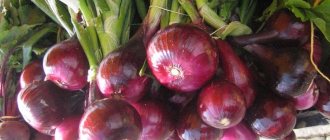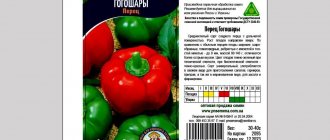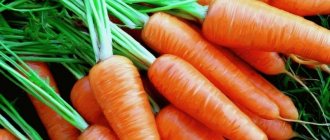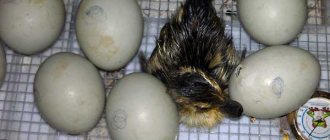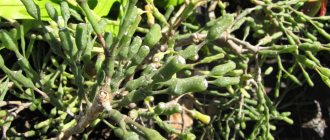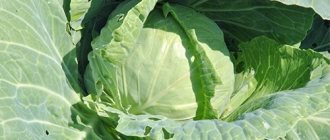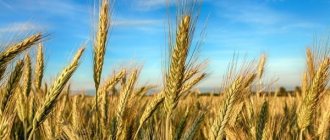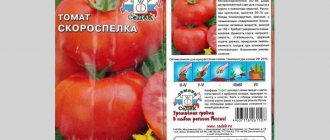←GO BACK
29.10.2019
Winter crops are varieties that are planted in the fall and grow during winter and spring. The harvest of such crops is distinguished by high quality and valuable nutritional properties, and the volumes and shelf life are much higher than those for spring crops.
- Methods of tillage for winter crops
- Features of sowing
- Growing and care technologies
- Overwintering and main causes of death
- Equipment for processing winter grain crops Harvesting winter wheat
- Harvesting winter rye
The main advantages of winter varieties:
- accumulation of mass in the autumn and spring periods;
- a strong root system that can survive the winter and be saturated with moisture;
- suppresses the growth of weeds;
Winter grains include: special varieties of rye, wheat, barley and triticale. The stages of the growing season are divided into the autumn period - about 50 days and the spring-summer period, which takes more than 70 days.
Methods of tillage for winter crops
Before planting winter varieties, the soil is carefully cultivated: cultivated in the spring-summer period (at least 4 times) and the soil is peeled using the autumn method. During the first plowing, harrowing is used; if the soil is subject to deflation, walk-behind tractors and subsoilers are used.
In order for the soil to be structural, dense, and contain a sufficient amount of moisture and nutrients, the following are planted: oat vetch, fodder lupine and other green mixtures. After planting a fallow crop, the soil acquires the necessary supply of valuable substances, micro and macro elements for winter crops and ensures the cleanliness of the field. Before planting, treatment is carried out using the fallow method or limited to surface techniques.
Protection from pests and diseases
The most stable elements of winter rye agrocenoses invariably remain grain flies, grain sawflies, grain aphids, harmful bugs and grain beetles. The need to carry out protective measures against aphids arises only in certain years, and it should be based on systematic monitoring of the state of the population.
In the harmful turtle, the main damage is caused by the larvae on the ears during the grain filling period. Carrying out protective measures becomes a real necessity if there are 5 or more larval bugs per 1 m2 during the grain formation period. A dangerous pest of winter rye is the grain beetle and related species - the red beetle, the crusader beetle. They inflict losses by knocking grains out of ripening ears. The most acceptable method is to control adults using agrotechnical measures, since ground-based equipment is not effective in working on crops with high (up to 110 cm) stems. Root rot, leaf rust and powdery mildew are constantly present on rye crops in the Central Chernobyl region. From time to time, especially in the northern part, plants are affected by snow mold. Septoria, like stem rust, is observed extremely rarely on rye, but at the same time causes great damage to the crop yield. To reduce losses from these diseases, preference should be given to locally bred varieties. Saratov varieties, developed in the specific conditions of the extreme southeast, are less resistant to such diseases. The harmfulness of snow mold is especially evident when there is insufficient moisture reserves in the soil in the early spring. With a good supply of moisture, the death of affected plants is compensated by additional tillering of the surviving ones. Powdery mildew damage to plants occurs more often in conditions favorable for growth. The spread of the disease can reach 100%, but development is much slower and most often subsides after the exit phase. Leaf rust is more harmful. The combination of leaf rust damage to plants and subsequent drought is especially dangerous. The optimal way to protect rye crops from this disease is to select resistant varieties (Talovskaya 33, Talovskaya 41). In their absence, fungicidal treatment is necessary at the first signs of the disease.
Features of sowing
Specific recommendations for sowing winter crops can only be described depending on the type of plant and climatic conditions of growth. Active temperatures and the percentage of moisture and nutrients in the soil are important, so the plants can grow stronger and withstand winter frosts. General recommendations for planting winter crops will be as follows: the soil is freed from weeds by mechanical or chemical treatment, and after sowing it must be treated to prevent the appearance of snow mold.
Sowing of winter plants is divided into: narrow-row (7-8 cm), regular (15 cm), cross-row and cross-diagonal (row direction is north-south). The planting depth is determined by specific soil indicators (humidity, etc.) and climatic conditions.
Harvesting technology
There are two main ways of harvesting grain: separate harvesting and direct combining. When combining, rye ready for mowing is harvested at full ripeness at a humidity of 10-16%. The grain is immediately threshed, and the straw is placed in stacks. With the separate method, the ears are mowed and placed in windrows on the field. After a couple of days, when the windrows have dried, they are collected by a combine using a pick-up and threshed. The advantage of separate cleaning is economic profitability. Both harvest time and grain loss are reduced. Grain is also harvested using a separate method if May and June were dry and then there was heavy rain. In dry weather, the grass grows poorly, and subsequent precipitation leads to the active development of weeds.
Single-phase cleaning
In rainy weather, a single-phase method is recommended, since the rollers will not have time to dry and the grain will deteriorate . If the rains begin when the windrows have already been formed, then they are shifted at an angle of 10-30°. This will allow water to drain and reduce crop loss.
In arid regions, the method of in-line harvesting of grain and straw is practiced. To do this, remove the stacker from the grain harvester and install a straw chopper. The processed straw is sent to a special trailer for transportation and stacking.
If there are a large number of weeds in the field, high humidity and severe lodging of the stems, then combine harvester tow is used. The stalks of the cereals are captured by the combs and pulled through the gap between the teeth. The grain is separated and, under the influence of air currents, enters the drift conveyor, and from there into the thresher.
Transportation of rye grain
Fields intended for growing seeds for sowing are usually harvested using a separate method. The presence of seeds in the ears improves the quality of the grain, increases the content of nutrients in it and makes the seedlings stronger.
In regions with a short ripening period, an agrotechnical technique such as drying on the root is used. After this, the grain is harvested by direct harvesting.
Growing and care technologies
To obtain a high yield of winter crops, fertilizing and various soil cultivation methods are used as care measures.
Regarding the application of fertilizers, mineral and nitrogen additives are mainly added. The application of nitrogen-containing substances occurs in three approaches: before the start of the growing season (to increase tillering power), at the beginning and in the middle of the booting process. To increase harvest volumes, other mineral fertilizers are also used, for example, manganese, copper, etc.
Organic nutrients are applied only when the soil is low in fertility or in the case of crops such as oats, buckwheat and other annual grasses. Such fertilizers are applied only for plowing.
To obtain high yield percentages, care should be taken to control pests, diseases and weeds. Particular care should be taken when treating plants in the tillering stage.
What are the features of growing winter rye?
The main advantage of growing winter rye is the winter hardiness of the crop . Crops can easily withstand cold temperatures down to -25...-30°C, even if there is no snow cover. In harsh conditions, the yield of some varieties is 20-30 centners per hectare. Wheat simply cannot withstand such frosts.
Winter rye varieties branch well; 3-8 spikelets grow from one grain . The plants grow quickly, displacing weeds from the fields, including wild oats and thistle. Winter rye is used as a precursor before sowing row crops and spring cereals. They are grown in soils with high acidity, which wheat and other cereals cannot tolerate.
Winter rye is used as an early green manure in organic farming . It displaces weeds and loosens the soil. Long roots lift useful minerals from deep layers of soil. After warm weather sets in, the young shoots are cut off and the main crop is sown on the field.
Mown rye quickly rots and serves as fertilizer for new plantings.
How rye grows
Rye is a herbaceous annual plant with a hollow, bare stem . Cultivated varieties have an average height of 80-100 cm.
Other characteristics:
- leaves are fleecy, with a characteristic bluish color;
- the root system is fibrous, branched, reaches a depth of 1-2 m;
- from each seed 6-8 shoots grow, under favorable conditions - up to 90;
- the stem ends in two-row spikelets;
- the fruit is an elongated (5-10 mm), slightly laterally pressed grain, 1-3 mm thick.
The weight of a thousand seeds depends on the variety . In diploid seeds, 1000 seeds weigh 20-35 g, in tetraploid seeds - 50-55 g.
Interesting things on the site:
Varieties of rye: seed, winter and other varieties
What kind of cereal is made from rye and its beneficial properties
Where is it grown?
Rye was the main grain crop in Europe for a long time , after which it gave way to wheat and barley. It is believed that the ancestral home of modern cultivated species was Turkey, where rye was considered a weed. After the spread of grain farming in the northern territories, people paid attention to cereals due to its cold resistance.
Now rye is grown in many countries . In the Russian Federation, the most favorable regions for the cultivation of cereals are the republics of Bashkiria and Tatarstan, Orenburg, Saratov, Kirov and Volgograd regions.
In Yakutia and Transbaikalia, only spring varieties are grown, since winter varieties are not able to survive very cold winters.
In the southern districts and regions of the Russian Federation, rye is not grown, since the fields are allocated to more productive and valuable crops: wheat, corn, sunflower.
Overwintering and main causes of death
Overwintering is certainly an important advantage, but are winter crops able to withstand all conditions?
Experts identify three main risk groups: unfavorable weather conditions, non-compliance with agrotechnical standards, and incorrect selection of varieties. The following reasons for the death of winter crops are identified:
- Freezing
Low temperatures are not dangerous for winter crops only if there is good snow cover. The likelihood of death occurs in the off-season, when the snow melts and the frosts have not yet subsided. At this stage, plants already lose their frost resistance properties. To prevent this, experienced agronomists make shelterbelts or canopy sowings.
- Wetting and damping off of plants
Another problem is improper planting and getting wet of plants due to the accumulation of melt water. To eliminate this, drainage furrows and vertical drainage are created.
- Blowing out the top layer
If the soil is not prepared correctly, the structureless layers are quickly blown away - because of this, the plants will most likely dry out during tillering.
- Ice crusts
Special snow retention systems will prevent the formation of crusts under the snow or during freezing melt water.
- Drought in the off-season
At low humidity and temperature, plants do not receive proper nutrition, resulting in a sharp reduction in the number of shoots. Snow retention systems will also help to avoid this.
Use of rye: tasty and healthy
The dried grains are ground into flour, from which they make cereal or bake very nutritious and healthy black bread. It is considered a product of rich people. Moreover, the bran, straw and chaff of the crop are used to feed livestock. In addition, many will be interested in learning how to germinate rye. First, the grains are sorted and then soaked (the water should cover them by 1.5 cm).
The technology of this process is very simple:
- the container is placed in a warm room;
- change the fluid every 3 hours for 12 hours;
- after the time has passed, the grains are washed under running water;
- they are placed in a bowl and covered with moistened gauze (the cloth is folded 5-6 times);
- The dishes are left in this condition for 4-6 hours.
Since it is quite easy to germinate rye, this procedure is repeated several times a season. Store it in the refrigerator for 5 days. Wash thoroughly before use. Doctors recommend chewing the grains well so that the beneficial ingredients are absorbed faster.
This completes the process of growing rye. However, farmers are looking forward to autumn or spring to sow crops again.
Equipment for processing winter grain crops
Different varieties of winter crops have their own agrotechnical standards applied to determining ripeness and harvesting.
Harvesting winter wheat
Winter ripening is revealed by the degree of waxy ripeness (moisture content - 35-45%), when the spikelets and grains become yellow. Harvesting can begin when 75% of the plants reach ripeness. Winter wheat harvesting usually occurs in a single-phase or two-phase manner. The first method is less expensive in terms of cost, but its implementation is possible only if the moisture content in the grains is 15%. Usually, seed zones of fields are collected in this way, because The germination rate of such seeds is very high.
In a separate (two-phase) method, the fields are mowed with reapers into separate windrows and threshed only on the second or third day. Flour from such wheat retains nutritional value and has high baking qualities.
Harvesting winter rye
Harvesting this crop is associated with the risk of not harvesting large volumes of grain due to incorrect determination of maturity: a high percentage of humidity leads to overloading of dryers. As when harvesting winter wheat, rye is harvested using single-phase or two-phase methods for no more than 8-10 days, because grain tends to crumble and germinate. Mowing into windrows (two-phase) usually occurs at a humidity of 20-30%, then after drying they are selected for threshing. The direct method requires a humidity of no more than 15-17%. In high climatic humidity, it is important to adjust the combine harvester correctly, because... Long wet straw can curl up and clog the drum. After threshing, straw is usually collected from the field to prepare the soil for subsequent planting.
How to determine the maturity of rye
In grain growing there are 3 stages of ripeness:
- Dairy;
- Wax;
- Complete.
Rye of waxy ripeness
From a physical point of view, the stages differ in the ratio of starch, water and protein in the grain. The timing of the start of harvesting work is determined not only by actual ripeness, but also by the completion of the grain filling process, the rate of ripening, weather and harvesting method. If during the period of increase in the mass of the cereal there is warm weather with moderate humidity, then it takes more time for ripening than during lodging, dry or wet weather. How long it takes for rye to ear also depends on weather conditions: in dry weather this process lasts longer.
Preparing sheaves for maturity testing
To determine the level of ripeness, the degree of cessation of weight gain of 1000 grains and their moisture content are determined . For this purpose, an express method is used, which involves working with an artificial dye - eosin. The analysis begins by preparing a one percent solution of 250-300 ml of water and 2.5-3 g of dye. Then 20-30 intact plants with roots are collected from the field in several places. The sheaves are tied up and marked with the obligatory indication:
- Field area;
- Varieties;
- Predecessor cultures;
- Collection dates.
In the laboratory, an ear with a stem about 20 cm long is cut and dipped in the prepared solution for 2-3 hours. If the movement of dry substances continues in the grain, the ear scales will become colored. Harvesting can begin if out of 100 ears no more than 15 have changed color. This procedure is carried out daily to determine the optimal time to start work.
Winter rye is the first to ripen before harvest, so samples begin to be collected from winter fields. Spring varieties begin to be checked after the winter crops are harvested.
Preserving the nutritional value of grain
How to maintain the productivity potential and nutritional value of harvested grain? This can only be realized if all agrotechnical standards are observed: rules for tillage, planting, harvesting and proper threshing. In addition, the growing conditions are important - the composition of the soil, the absence of weeds, diseases and proper sowing with drainage structures and the structure of the furrows that preserve the plants from frost and rotting. Such conditions can only be ensured by a professional approach and modern agricultural technologies, choosing high-quality seed mass, fertilizers and equipment and performing all work on time.
Fertilizer system
Fertilizers for this crop are applied based on the results of an agrochemical soil survey. With an average level of available phosphorus content and an increased level of exchangeable potassium, the average recommended rates of mineral fertilizers should be applied to rye: on podzolized and leached chernozems - N30-60P60K60, on typical and ordinary chernozems - N30-60P30-60K30 and N30P60K30, respectively, for varieties of new architecture – N60-90P40-60K40-60. With a yield of up to 3 t/ha, winter rye satisfies the need for microelements due to their reserves in the soil and impurities in simple fertilizers. When planning a yield of more than 4 t/ha, there is a need to introduce microelements. The use of microfertilizers increases the yield of winter rye, improves grain quality, and increases plant resistance to adverse factors. The need to add microelements arises when the soil content of boron is less than 0.4 mg/kg, copper - less than 2.0, manganese - less than 40, zinc - less than 1.0. The most beneficial is pre-sowing seed treatment with microelements together with dressing. In the case of foliar treatments, microelements can be applied in a foliar manner together with physiologically active substances.
Varieties and seed preparation
Among the varieties of winter rye recommended for cultivation in the Central Black Earth region, varieties of local and Saratov selection predominate. Varieties of local selection created by scientists from the Research Institute of Agriculture Central Emergency Plant named after. V.V. Dokuchaev, as a result of 40 years of targeted breeding work, present a new original morphotype of the rye plant. It was created using a short stem source and is characterized by high productivity and adaptability. It differs from common varieties in its relatively short, lodging-resistant straw, increased resistance to the most common diseases, drought and germination of standing grain. Among these varieties are Talovskaya 41, which took first place in the ranking in terms of yield among those in the State Register, as well as an earlier breeding variety Talovskaya 33, which is distinguished by a fairly high group resistance to the most common diseases and especially to root rot.
Acceptance of experiments
The varieties of Saratov selection are distinguished by unique drought resistance and high frost resistance. They combine these properties with a significant level of productivity. The latter is especially typical for the Marusenka variety, which took second place in the ranking in terms of yield potential. The responsiveness of these varieties to the use of fertilizers in the dose range N30-90P20-60K20-60 ranges from 1.0 to 3.0 t/ha. Sowing well-prepared, disinfected seeds of the best high-quality varieties ensures an increase in grain yield by 15–20% or more. Treating seed material has become mandatory in the conditions of the Voronezh region. Highly cleaned and sorted seeds of the 1st class are treated simultaneously with additional preparations selected according to the intended purpose, and focusing on the combination of pesticides and agrochemicals approved for use in our country. To disinfect winter rye seeds, a proven option would be to use drugs based on active ingredients - difenoconazole + cyproconazole.
Sowing dates have moved forward
Modern short-stemmed rye varieties are more demanding when it comes to sowing. It has been established that wintering conditions are better tolerated by plants that have developed 3–4 tillering shoots by the time the autumn growing season ends. If sowing is too early, in years with warm and humid weather, the rye overgrows, develops an excessively powerful vegetative mass and, as a result, is more susceptible to snow mold. If the autumn is dry, then early sown rye quickly consumes soil moisture, and the plants turn out to be weak and do not winter well. Maximum late dates also result in low-yielding crops, since plants do not have enough time and resources to form a developed primary root system. Plants do not have time to bloom well and undergo hardening. Timing is also of great importance from a phytosanitary point of view. Now it is necessary to review the established timing of sowing winter rye, taking into account the experience of recent years - gradually changing weather conditions during the autumn development period and new varieties. The previously considered optimal time for sowing winter crops in the period from August 25 to September 5 must be shifted to a later date: for busy fallows - from September 1-5, for black fallows - from September 5-10.
Useful properties of rye grain
Not only flour is made from rye grains, but also flakes, bran, kvass, and strong alcoholic drinks. Different types of bread, crispbread, desserts, pastries and various sweets are made from flour. All these products are distinguished by their low calorie content and rich vitamin and mineral composition.
Chemical composition
Rye is much healthier than wheat or oats. Its protein contains many amino acids and some gluten. Rye contains a large amount of fiber, which improves intestinal function and hemicellulose.
Of the vitamins, 100 g of grains contains:
- Vitamin A - 1 mcg;
- Beta-Carotene - 0.007 mcg;
- Thiamine - 0.316 mg;
- Riboflavin - 0.250 mg;
- Choline - 30.5 mg;
- Pantheonic acid - 1.5 mg;
- Pyridoxine - 0.3 mg;
- Folates - 38 mcg;
- Tocopherol - 0.9 mg;
- Phylloquinone - 6 mcg;
- Betaine - 150 mg.
Macroelements are represented by calcium, potassium, magnesium, phosphorus and sodium. Microelements - iron, copper, selenium, manganese and zinc. Of the essential amino acids, grain contains:
- Valin;
- Histidine;
- Arginine;
- Leucine;
- Lysine;
- Threonine;
- Tryptophan;
- Methionine;
- Phenylalanine.
The non-essential amino acids in the product are aspartic and glutamic acid, alanine, serine, glycine, tyrosine and proline. The grain contains Omega-3 and Omega-6 fatty acids, saturated fatty acids - palmitic, stearic and myristic, monounsaturated fatty acids - palmitoleic, gadoleic and oleic, and polyunsaturated fatty acids - linolenic and linoleic.
What are the benefits of grain
Rye grain is an excellent natural antioxidant, anti-inflammatory and anti-allergenic agent. Rye products strengthen the immune system, improve blood circulation and the functioning of the intestines and cardiovascular system. Regular consumption of rye bread or crispbread, bran or flakes is a prevention of cancer.
Another beneficial property of rye grains is to cleanse the body of toxins. They also help in the treatment of respiratory diseases, gastrointestinal diseases, and eczema. Rye improves metabolic processes in tissues, the functioning of the lymphatic, endocrine, and nervous systems.
Rye flour products are prescribed during recovery after serious illnesses, operations, and childbirth. For diseases of the thyroid gland and heart disease, rye bread and bran must be included in the menu. A decoction of rye bran helps with atherosclerosis, diarrhea, tuberculosis and hypertension.
The benefits of sprouted grains
Nutritionists value sprouted rye for its rich vitamin composition. The concentration of minerals and nutrients in sprouted grain is several times higher than in dry grain. Regular use of the product increases emotional and physical endurance, increases activity, strengthens muscle and bone tissue, improves coordination of movements, memory, and concentration. Rye sprouts are recommended for diabetes, atherosclerosis, diseases of the gallbladder and gastrointestinal tract, diseases of the organs of vision. Sprouted rye is also included in the diet menu.
How to germinate rye
For germination, grain from the previous harvest and not treated with chemicals is selected. The seeds are washed several times with warm running water and placed on a tray covered with a damp cloth. The top of the grains is covered with another piece of cloth and filled with water. The liquid should cover the seeds by 1-2 mm. Every day, the seeds need to be washed and the water in the tray changed - otherwise oxidation and the development of mold or drying out cannot be avoided. The first shoots appear after 2-4 days. Before use, it is advisable to rinse the rye sprouts with cold water to eliminate the unpleasant odor.
Interesting facts about rye culture
Rye is the record holder among herbaceous plants for the length of the root system. Under good conditions and nutritious soil, the total length of the plant's roots can reach 500-600 km, occupying a large area (up to 250 sq.m). The weight of roots per hectare reaches 6000 kg. In nature, wild rye species can reach a height of 3 m.
Rye bread was an important part of the life of the Slavs. Rye was also used to feed livestock, roofs were covered with straw, mattresses were stuffed, and stoves were heated. Among the Slavic peoples, rye was associated with vitality and love of life, resistance to the forces of evil and the community of worldly life.
The origin of the word “rye” has several versions. According to one of them, the modern word became a derivative of the Old Russian “rye”, which is similar to the verb “to give birth”. For this reason, farmers still use the expression “the harvest is born” today. According to another version, the word “rye” comes from “rye”, which means sunny, bright, and has common roots with the name of the sun god in the beliefs of the Slavs (Yarilo).
Rye is the only grain crop that is cultivated in all climatic regions.
It is grown both in Yakutia, with cold and short summers, and in Colombia, with a hot and humid climate. It is also classified as a plant that quickly loses its germination capacity: after 3-4 years, rye seeds lose their ability to germinate by more than 70%.
Winter rye is grown in many regions of Russia. It is sown where wheat or oats will not produce a good harvest or will die from unfavorable conditions. The benefits of cereal are enormous: the grain is rich in a number of essential acids, vitamins, enzymes, micro- and macroelements. Rye is used not only in the food industry; it is a valuable feed crop, an effective green manure and a valuable raw material for the production of biofuel.
There are all preparations for rye
– Rye is called an original Russian crop; it has been grown here for centuries. Unfortunately, now it has become poorly cultivated, although the demand for this grain is stable, says the acting director. Director of the Voronezh representative office Sergei Berdnikov. – Bread is baked from flour in large volumes; the grain is good for fodder.
Sergey Berdnikov
The crop is unpretentious in cultivation and can serve as insurance. Nowadays, products from global manufacturers, as well as generics, are used for the production of winter rye. There is almost the entire line of drugs necessary for use on the crops of this crop (although it is narrower than for growing other grains). We always have the appropriate fungicides, insecticides and herbicides in stock. There are also highly effective seed protectants, and they will be needed soon - the sowing of winter crops is just around the corner.
Alexander TOROP, Doctor of Agricultural Sciences, Chief Researcher of the Research Institute of Agriculture of the Central Black Earth Strip
